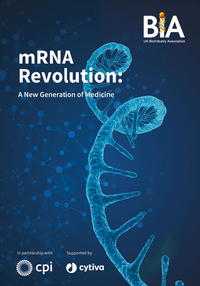mRNA Revolution: A new generation of medicine
The mRNA Revolution report reveals how the UK is poised to become a global leader in mRNA medicine, an emerging technology that rose to prominence during the COVID pandemic but has vast potential beyond.
The importance of this technology has been highlighted by the recent Nobel Prize in Physiology or Medicine award to Dr. Kariko and Dr. Weissman for their discoveries concerning nucleoside base modifications that enabled the development of effective mRNA vaccines against COVID-19.
What is mRNA
Simply, mRNA is a molecule that carries instructions from DNA to the ribosomes, where proteins are made. Proteins are the building blocks of life and are responsible for a wide range of functions, including cell structure, metabolism, and signalling.
Deoxyribonucleic acid (DNA) is a molecule that contains our genetic code, the blueprint of life. This essential molecule is the foundation for the “central dogma of biology”, or the sequence of events necessary for life to function. DNA is a long, double-stranded molecule made up of bases, located in the cell’s nucleus. The order of these bases determines the genetic blueprint.
To ‘read’ these blueprints, the double-helical DNA is unzipped to expose the individual strands and an enzyme translates them into a mobile, intermediate message, called ribonucleic acid (RNA). This intermediate message is called messenger RNA (mRNA), and it carries the instructions for making proteins.
Impact of mRNA
Traditional vaccine platforms struggle with the costs of manufacturing, scale capability and lengthy development times. RNA vaccines harness our own body to make a small protein to teach the body’s immune system to recognise it as foreign. The use of a genetic code lends itself to a “plug-and-play” vaccine approach with rapid development times, lowering the overall costs.
The processing time is also a lot shorter than traditional biologics production where a host cell line or egg-based platform are used to create the proteins of interest.
Another advantage to the technology is that only small doses are required for vaccines and as such they can be produced at smaller scales allowing the use of smaller manufacturing facilities.
.png)
.png)
